Dante has been an ever-present at the heart of Nice’s defence for each of their first six Ligue 1 games of the 2020/21 campaign. As one might conclude by the fact that he has been on the pitch for the full 90 minutes in each of Nice’s six Ligue 1 games at the start of this season, the 36-year-old Brazilian has also been one of Les Aiglons’ most important players this term, and in particular, during Nice’s build-up play.
At present, Nice sit in third place on Ligue 1’s possession table for the 2020/21 campaign, with Patrick Vieira’s side having kept an average of 58.6% possession in their first six league games of the season. They have also played the second-highest number of passes (3349) of any Ligue 1 side at this point of the campaign – trailing only Paris Saint-Germain.
Dante has been central to Nice’s heavily possession-based style of play thus far in the 2020/21 campaign, with the centre-back having played the highest number of passes (480) not just of any Nice player so far this season, but of any player in Ligue 1. Additionally, the former Bayern Munich man has got a 92.92% pass accuracy in France’s top tier from his opening six games of the campaign, which also, impressively, gives him the 28th-highest pass accuracy of any player in Ligue 1 despite the fact he has also played the most passes.
In this tactical analysis piece, in the form of a build-up-focused scout report, we will specifically look at Dante’s role for Nice in possession and during the build-up. This tactical analysis piece will show how important the 36-year-old’s ball-playing ability is for Vieira’s tactics and how important it is for his side when attempting to build attacks from the back.
Dante’s Positioning
To kick off this tactical analysis piece looking at Dante’s role in the build-up, we’re first going to look at his general positioning within Nice’s tactics.
The left-footed Brazilian plays in the left centre-back position for Nice, usually alongside right centre-back Andy Pelmard, who is 16 years his junior.
Nice’s central defenders tend to spend a lot of time on the ball and are usually required to play plenty of passes in a given game, as Les Aiglons are a heavily possession-based side that focuses on building up their attacks patiently from the back.
Dante’s left-footedness is, then, important for the left-sided centre-back in this system, as it tends to be easier for left-footed centre-backs to receive the ball on the left side of defence than it is for right-footed centre-backs, while left-footed centre-backs playing on the left side of defence can also create better passing angles and can potentially enjoy more potential passing options than a right-footed centre-back would in this position.
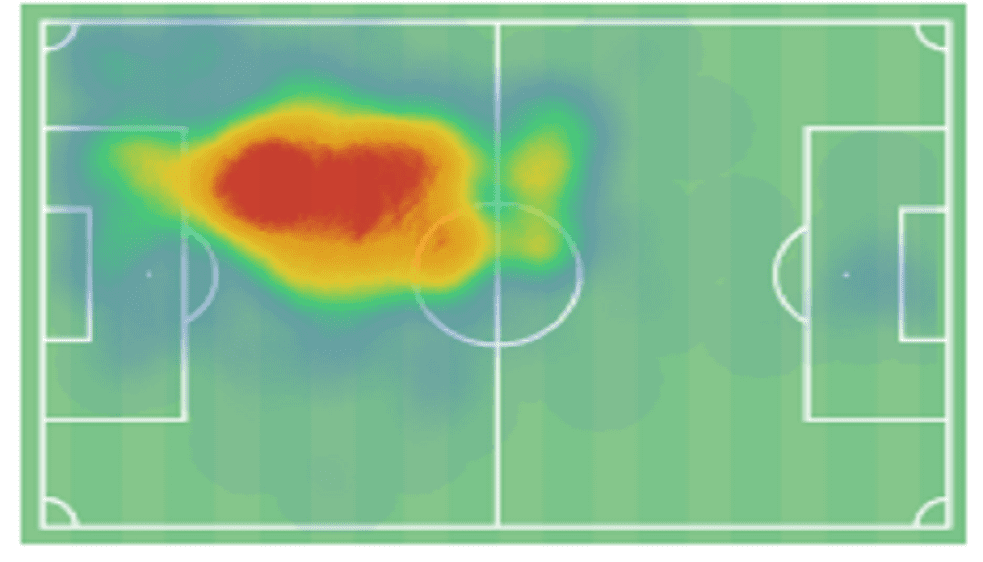
The image above shows us Dante’s heatmap from the first six games of the 2020/21 Ligue 1 campaign and as we can see, this also shows us that the position he generally occupies is the one you would typically associate with the left centre-back. While the 36-year-old doesn’t venture much beyond this typical left-sided centre-back position, however, it is clear that he covers plenty of ground in this general area and isn’t totally ‘stationary’ per se.
We will look at Dante’s movement, the area that he covers and the variety of exact positions that he moves into in his left centre-back position, at greater length later on in this tactical analysis piece.
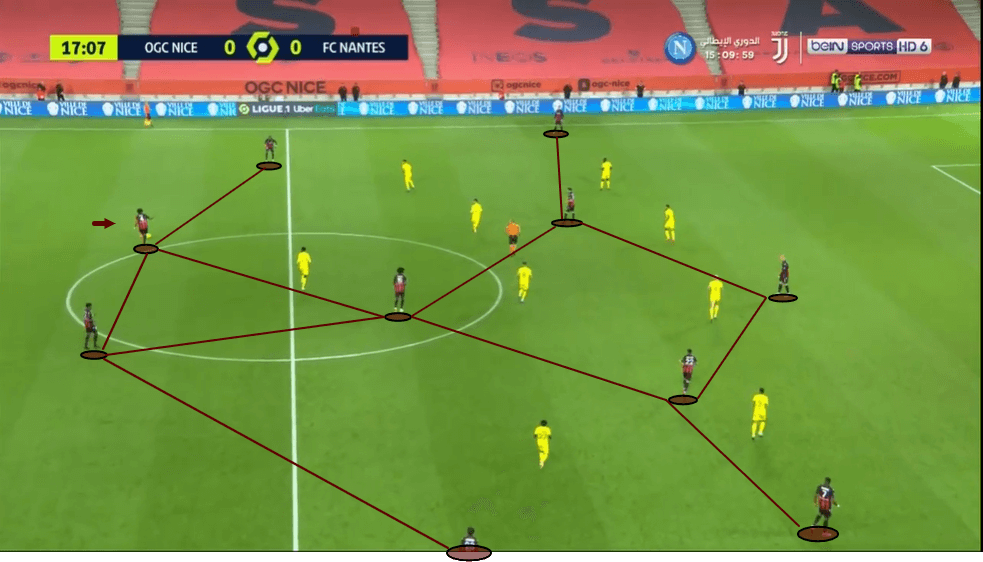
This next image shows us Nice’s typical shape during the build-up phase. As we can see, Dante is occupying the left centre-back position, with the right centre-back on the opposite side of the centre circle beside him, the holding midfielder positioned slightly more advanced and in between the two of them, and with both full-backs spread out wide, but still positioned relatively deep, not pushing beyond the same line as the holding midfielder.
Meanwhile, an offensive line of five is created by Nice’s centre forward, the two wingers and the two more advanced central midfielders in this 4-3-3 system that Vieira favours.
We can see Dante in possession of the ball here, with the opposition striker blocking off the potential pass into the holding midfielder. This is quite a common scenario for Nice to experience during the build-up, as they would typically play through the holding midfielder but when he is cut off, then this puts more of the onus on progressing the play on the centre-backs.
However, due to Dante being a high-quality ball progressor, this is not a major issue and their build-up play is not usually impacted greatly by the holding midfielder being marked tightly, as Dante is more than good enough to build into the midfield and/or attack.
Carrying the ball forward
One of the ways in which Nice get around the issue of their holding midfielder being marked tightly during the build-up is by having Dante carry the ball out from the back into the next line, picking up a position alongside the holding midfielder and essentially creating a 2v1 advantage against that player in the centre of the pitch.
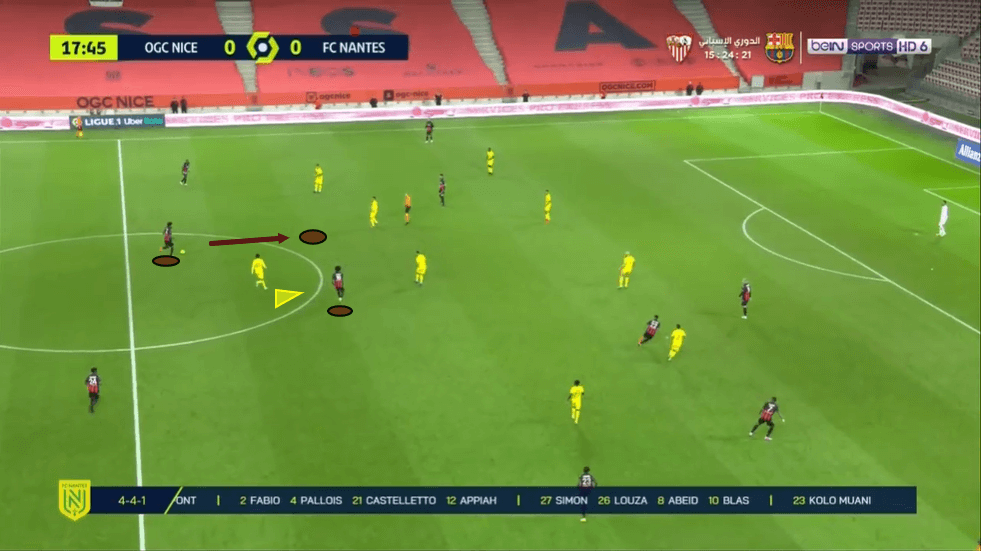
This image above shows was taken just under 40 seconds after the image which showed the holding midfielder being marked tightly in the previous section of this tactical analysis piece while we were taking a look at Nice’s general shape in the build-up.
It was clear that Dante couldn’t play the ball to the holding midfielder, due to the opposition striker’s positioning, however, as the image above shows us, there is space to the left side of this holding midfielder, who has orientated himself slightly to the right of central midfield.
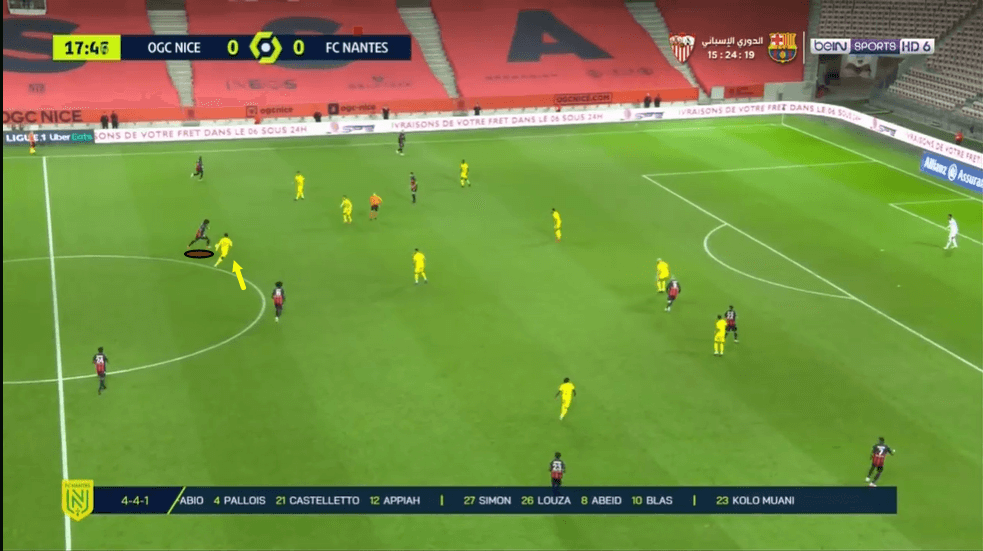
Dante carries the ball out from the back into this position, advancing into the centre of the pitch thanks to his ball-carrying ability, rather than relying on passing in this early stage of the build-up.
The Brazilian moves into this position that may have been occupied by a deeper left-sided central midfielder and as he does so, he eventually attracts pressure from the opposition centre forward who had been marking the holding midfielder.
This forward presses Dante while keeping the holding midfielder in his cover shadow, however, he, alone, is unable to prevent the centre-back from reaching this position alongside the holding midfielder and then advancing the ball upfield into Nice’s offensive line.
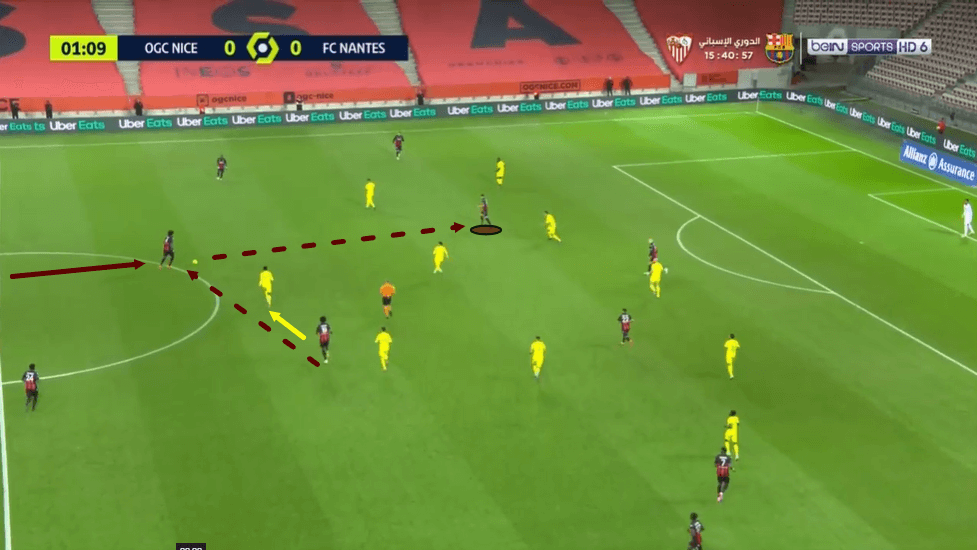
This next image, which is taken from this same Nice game, show sus another example of Dante advancing from the more natural, deeper, left-sided centre-back position into a position in line with the holding midfielder.
On this occasion, however, Dante didn’t carry the ball out from the back himself, and instead, he advanced into this position off the ball and was then found occupying the position by the holding midfielder when he was being pressed.
The opposition forwards pressed the holding midfielder on the right side of central midfield but then they left the left side of central midfield free and the Brazilian centre-back advanced into this space to make himself a passing option.
After receiving the ball in space, Dante can then play the ball up into Nice’s offensive line of five once again. When creating this offensive line of five, Nice put a player in the centre forward position, both wings and both half-spaces and Dante picks out the player in the left half-space with his pass on this occasion.
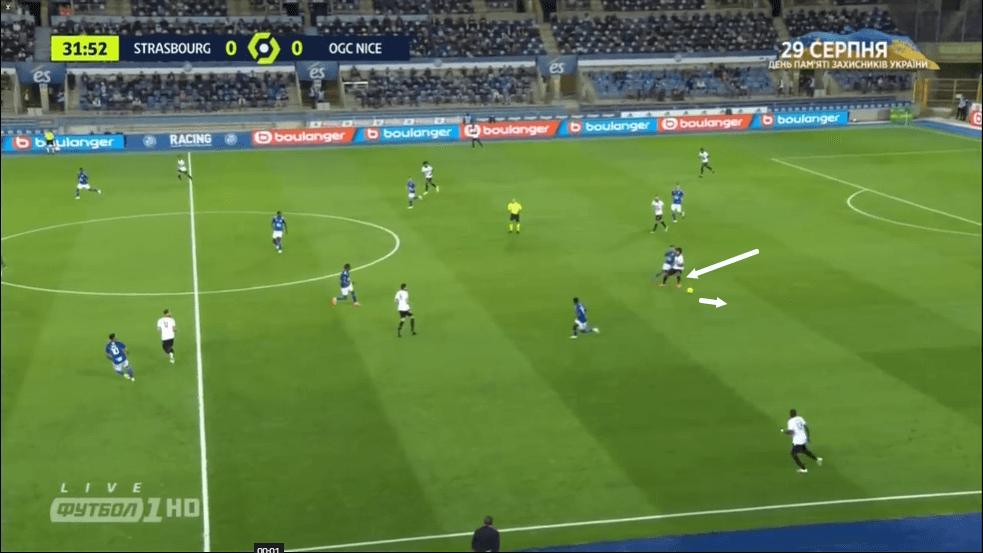
The previous two examples in this section showed us how Dante’s positioning, ball-playing quality and ball-carrying ability helped his side to build-up into the final third while bypassing the holding midfielder, who was being marked tightly, however, while this is a major part of Dante’s role in the build-up, Dante does often play the ball through this holding midfielder and this next image will show us one of the ways in which his ball-carrying ability helps his side to build through this player by attracting pressure, thus freeing the holding midfielder up.
In the image above, we can see Dante dribbling the ball out from the back again. On this occasion, he is being pressed quite aggressively, quite early on in the build-up.
However, Dante is quite a press resistant player. Despite not being the quickest or the most agile of players, he is capable of using his impressive ball control, his dribbling quality, his strength and his 188cm (6’2”) tall frame to his advantage when put under pressure in order to retain possession. We can see all of these attributes of Dante’s in action in this image above, as he holds off the opposition forward pressing him.
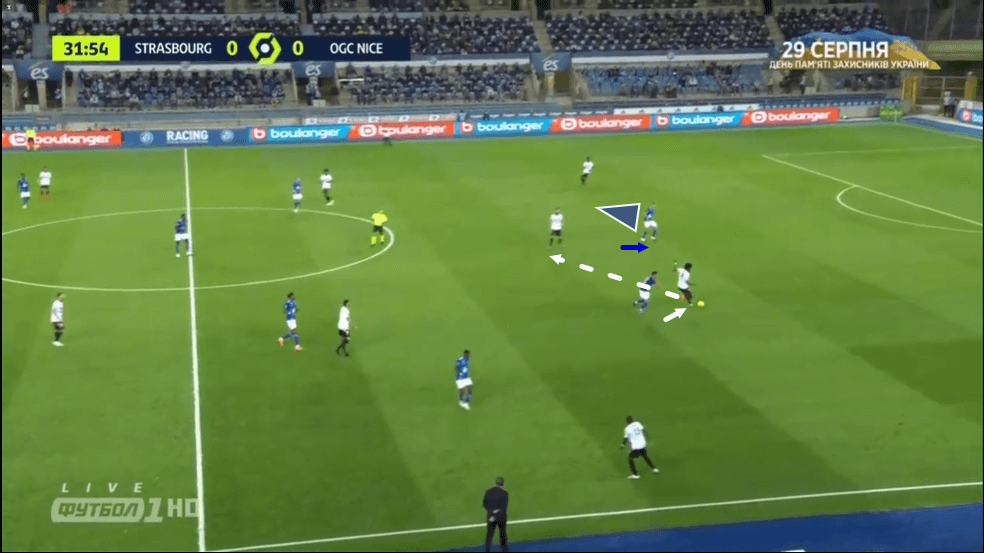
The centre-back turns back to his goal while holding off this player pressing him but the player stays tight to him. Meanwhile, as Dante turns back, the other opposition forward who had been marking the holding midfielder drops his position slightly in order to cover the passing lane between Dante and the right centre-back.
However, this creates space for the holding midfielder and as play moves on, Dante disguises a pass into the holding midfielder. On this particular occasion, Morgan Schneiderlin, the holding midfielder on this occasion, then plays the ball back to the goalkeeper anyway, however, this provides us with an example of Dante’s quality as a progressive passer in this Nice team and his press resistance, both of which are evidently big assets for Vieira’s side, as are the other on and off-the-ball qualities that we saw the 36-year-old demonstrate in this section of analysis.
Dante the quarterback
Carrying the ball out from the back is one important aspect of Dante’s role in the build-up, however, that is not the only way in which he contributes for his side during this phase of play and another important aspect of his game in the build-up is his long-ball-playing ability.
While he is comfortable with dribbling out from the back and carrying the ball upfield, Dante is equally comfortable with dropping deep and picking out passes from behind the rest of his teammates.
Dante has played a total of 44 long passes in Ligue 1 this season, which is the 16th-highest number of long passes that have been played by any Ligue 1 player at this point in the campaign. He has also got a 50% long-ball accuracy.
In addition to that, Dante has played the eighth-highest number of passes to the final third (54) of any Ligue 1 player so far this season with a 74:07% accuracy, while the Nice man has also played the fourth-highest number of progressive passes (74) of any French top-flight player this term.
Dante’s long passing is a particularly important aspect to his game when playing against a team that are not pressing the Nice backline very aggressively from the front, as this can allow Dante plenty of time and space on the ball in deep playmaking positions from where he can pick out long passes and potentially play teammates in behind the opposition’s defensive line.
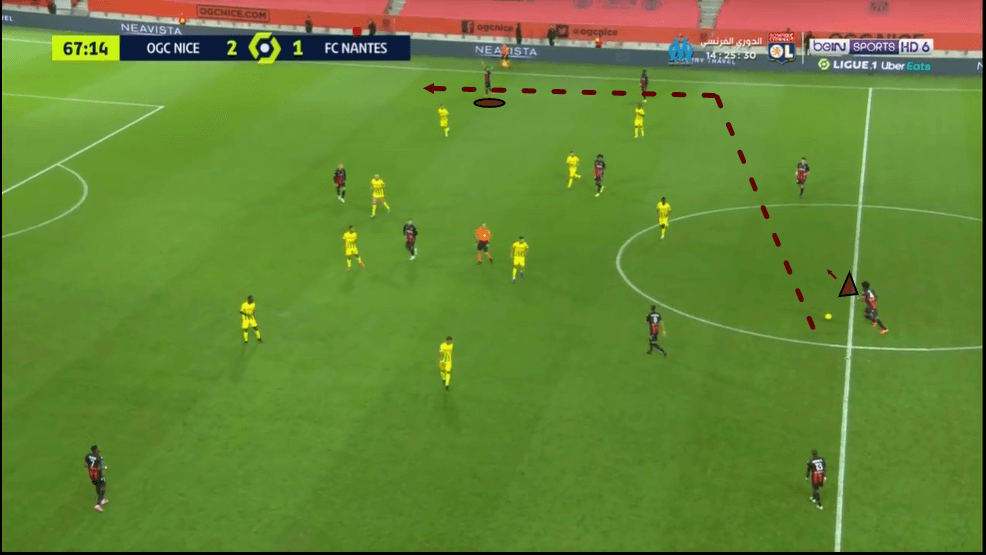
This image above shows us one such occasion when Dante enjoys time and space on the ball in a deep position from where he can pick out a long-ball to a teammate running in behind the opposition’s defensive line.
Here the opposition are not pressing Nice’s centre-backs, however, while they are seemingly doing a decent job at covering the central areas and preventing Les Aiglons from playing through them, their backline is also sitting fairly high and leaving plenty of space in behind for Nice to potentially exploit via a long-ball, which is exactly what happens here, as Dante plays this ball over the top for the right-winger who runs beyond the left-back to exploit this space in behind the backline.
Additionally, this ball from Dante, in the left centre-back position, to the player providing the width on the right, be it the right-winger or an advancing right-back, depending on the situation, is a pass that he likes to play quite often. In games where the Brazilian is given enough time and space to play long-balls, this is one that you will typically see him attempt on a number of occasions during a given game.
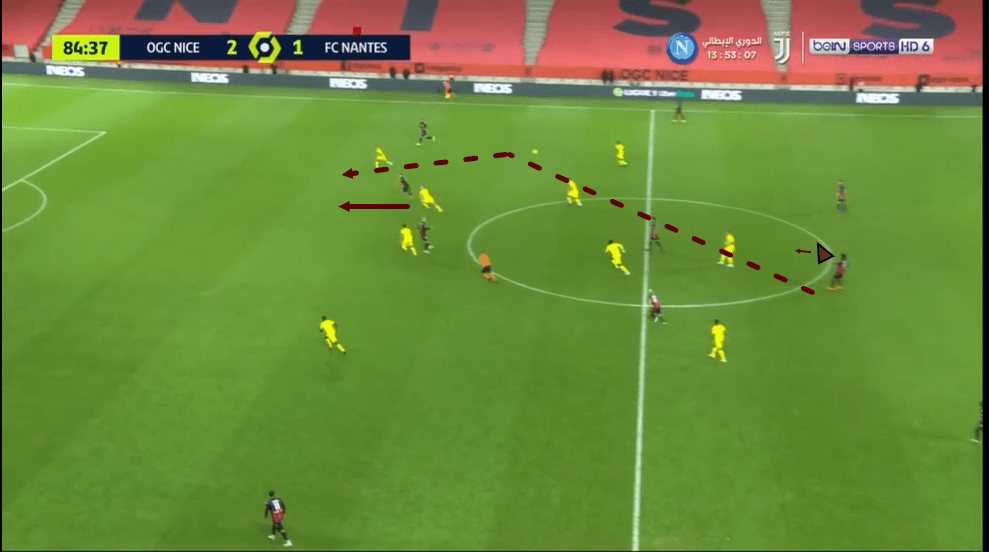
However, as this next image shows us, Dante doesn’t just spread long-balls from the deep central position out to the wide areas, as he also plays balls over the top, through the centre of the pitch for his teammates to run onto, while playing versus a relatively high line.
Again, here, he was not pressed aggressively by the opposition’s front line and their backline was sitting quite high. Additionally, the opposition’s backline wasn’t extremely organised and as a result, Dante managed to play an advancing teammate in on goal via a long-ball straight through the centre of the pitch and over the top.
As we can see, Dante has got plenty of versatility in terms of how he can help his side in the build-up. He is capable of carrying the ball upfield himself, while he is also capable of playmaking from deep areas of the pitch. His combination of being quite press resistant and dangerous when given time and space in deep areas of the pitch undoubtedly makes him a difficult man to deal with for opposition defences.
Feinting when receiving the ball
While what Dante does with the ball upon controlling it and attempting to advance play is evidently central to his role in the build-up for Nice, how the centre-back receives possession of the ball is also an important part of his role in the build-up and Dante consistently makes some interesting and effective movements upon receiving the ball.
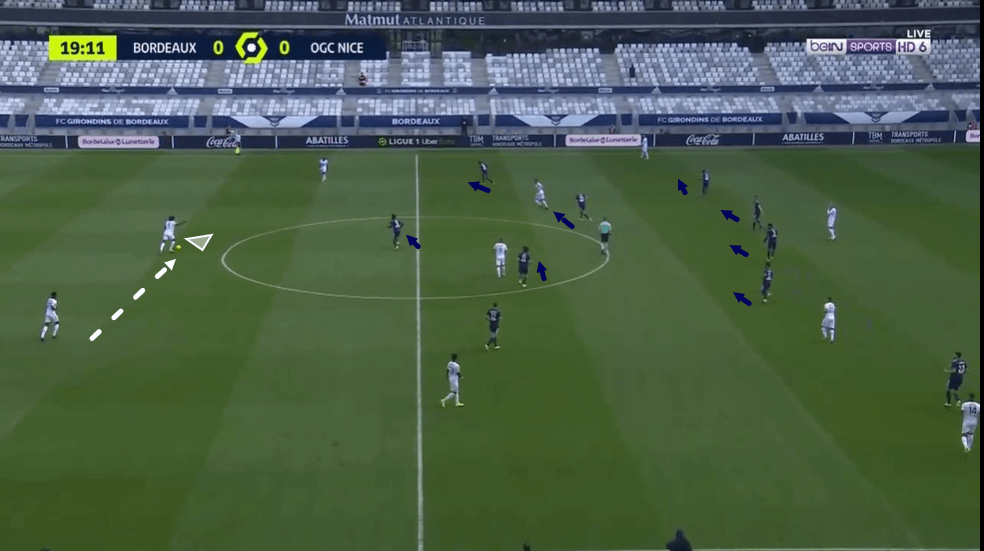
Dante often allows the ball to run across his body upon receiving it, which we can see one example of in the image above, which is made easier, again, by his positioning on the left side of defence as a left-footed centre-back.
As the ball runs across his body, Dante then ends up orientating his body to face the left-wing and in this image, we can see him beginning to lift his left leg, simulating the movement one would expect him to produce if he were playing a pass.
In anticipation for this pass, the opposition begin to shift over towards their right-wing, or Nice’s left-wing, which is also occurring in this image.
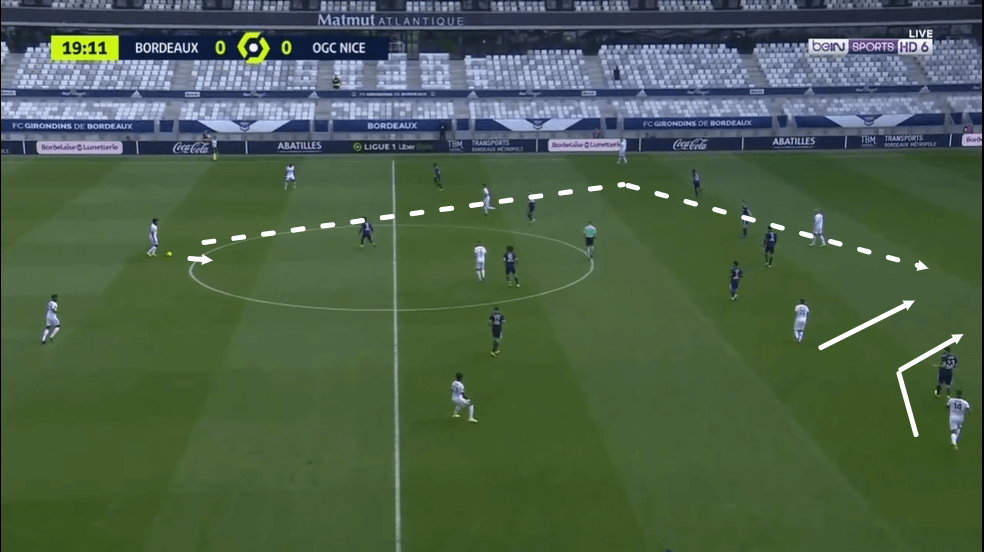
However, this is a feint from Dante and instead of driving the ball forward or out to the wing after pulling his leg back, he brings the ball under control, centres it and centres himself, which results in him now orientating himself more centrally, as we can see in this next image above.
In addition to slightly manipulating the opposition’s shape and potentially deterring the opposition centre forward from aggressively pressing him as he receives possession, with this body feint upon receiving the ball, this little movement which sees Dante centre himself more, buys the centre-back some more time to scan the pitch, spot areas of weakness in the opposition’s defensive shape and then try to exploit them via a progressive pass, which he does here.
Two Nice players end up running into the large space that has opened up between the opposition left-back and left centre-back here as play moves on and Dante plays the ball over the top into this channel in order to try and exploit this space. This may give us an example of how effective the Brazilian’s body feint was in allowing him to pick out the best possible passing option here.
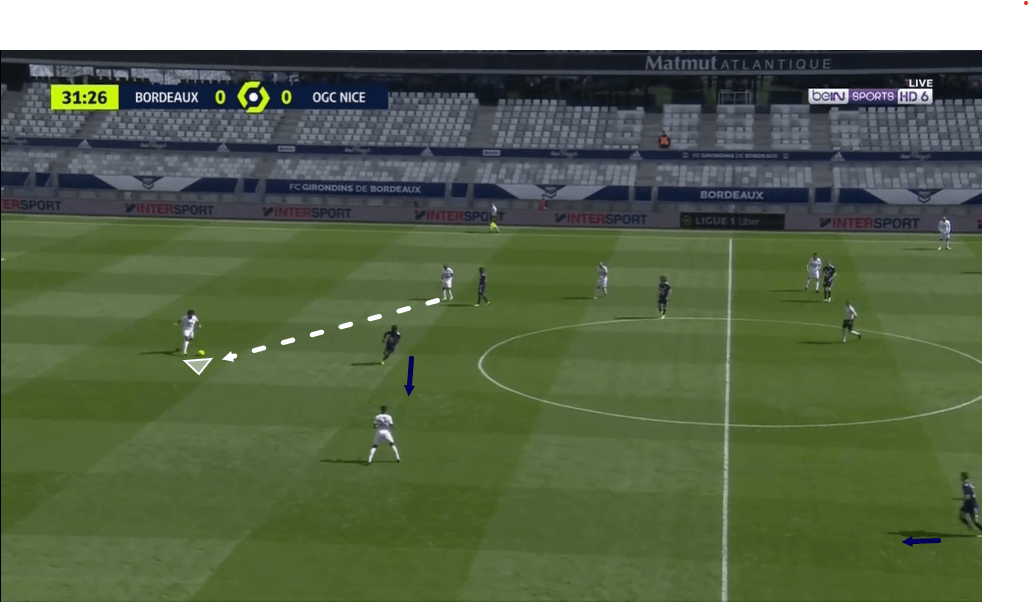
This next image shows us another example of Dante allowing the ball to run across his body, however, this time the pass is coming from his left side.
As he receives the ball here, he feints as though he is going to quickly relay possession out to the right centre-back and as he does so, the opposition centre forward begins to move out towards the right centre-back and, as a result, he doesn’t press Dante.
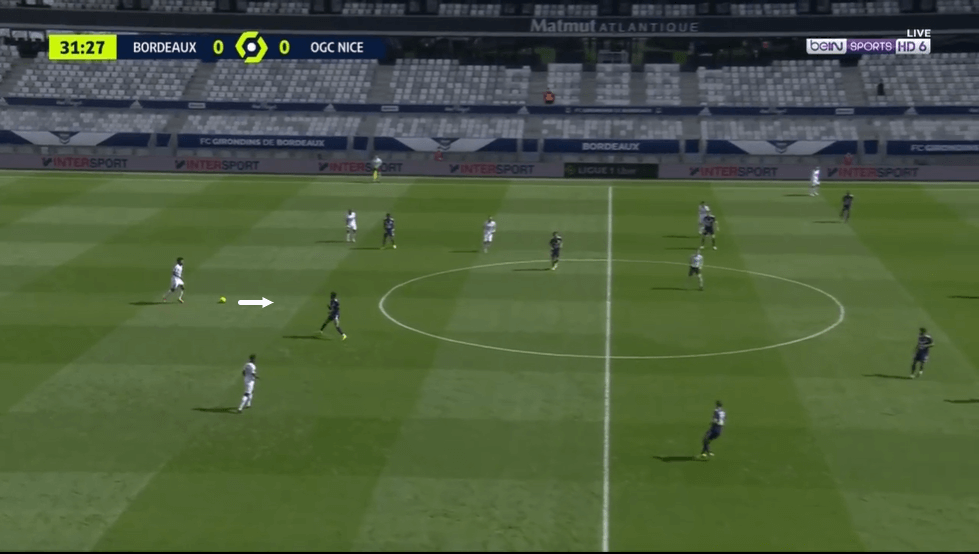
As play moves on, once again, the Brazilian simply controls the ball and centres himself to face the entirety of the pitch as he did in the previous example, allowing himself to enjoy more time and space on the ball to pick out the best possible passing option while having to deal with less pressure than he potentially would have, had he not pulled off this body feint when receiving the ball.
In addition to showing his calmness and his quality on the ball, these movements show us how intelligent the centre-back is and as these movements help him to pick out better passing options during games, they are clearly an important part of his role in the build-up for Nice.
Dante under pressure
We’ve already mentioned the player’s press resistance in this tactical analysis piece and we will take a closer look at this aspect of his game in this final section of analysis.
Firstly, Dante’s quality and calmness on the ball are pivotal for his side when building out from the back versus a team deploying an aggressive high press.
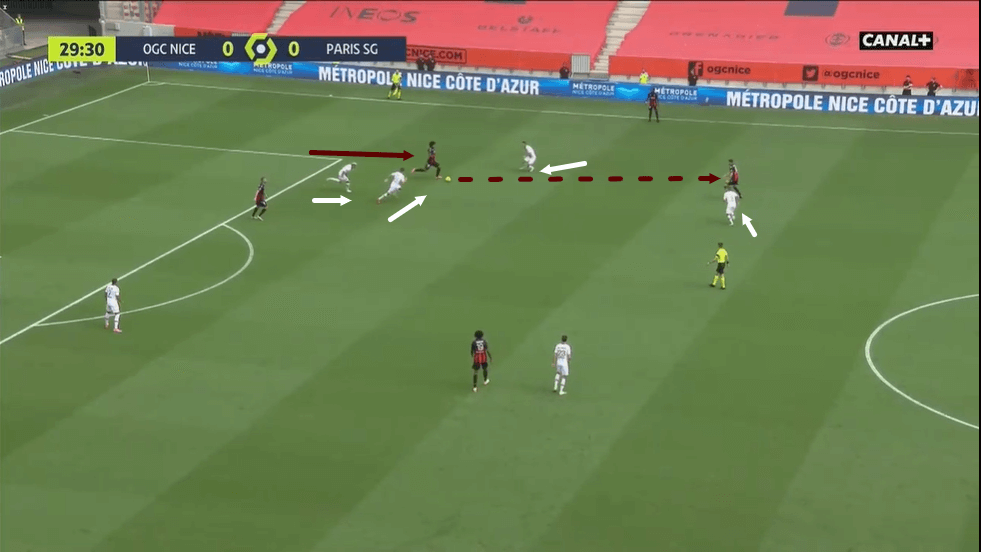
PSG are one such side that like to press high up the pitch and Nice have played against them in Ligue 1 this term. This game provided us with plenty of examples of Dante’s press resistance, one of which can be seen in this image above.
Here, we can see the 36-year-old being pressed by three PSG players during the build-up, just after a goal kick. The centre-back doesn’t panic in these situations, nor does he tend to rush play.
Just prior to this image being taken, he carried the ball slightly forward, attracting the pressing PSG players closer to him in the process and backing his own ability to play the ball past them and as play moves on, he manages to do just that, as he plays the ball to the right foot of the left central midfielder positioned just in front of him.
This is a good choice of pass, as this player can receive the ball and turn outwards to face forward or he can play the ball out to the left-back who can then carry the ball forward.
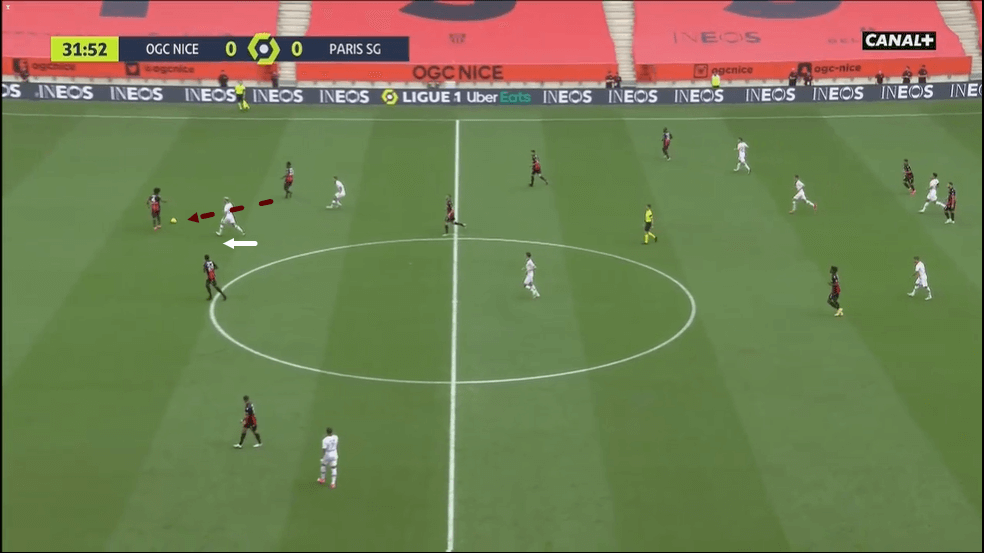
This next image provides us with another example of Dante’s ability to remain cool under pressure.
Here, we can see the Brazilian receiving the ball via a short pass from the left-back, who had been pressed by PSG’s right-winger. Now, as he receives the ball, Dante is set to be pressed himself by centre forward Mauro Icardi who is not positioned that far away from him here.
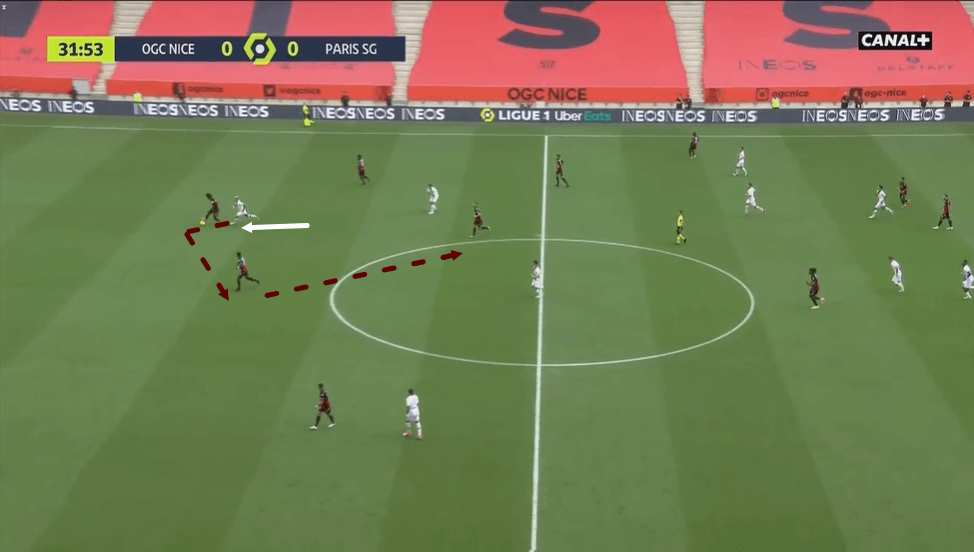
However, despite how close Icardi is positioned to him here before pressing him, Dante still remains calm and doesn’t rush the play. He allows the ball, once again, to run past his body and then, while being chased backwards by Icardi, Dante plays the ball across to the right centre-back, who we can see is free, who then quickly plays it into the holding midfielder, so this may show us another example of Dante’s composure on the ball at the back, as well as his positivity on the ball and how beneficial it can clearly be for Nice.
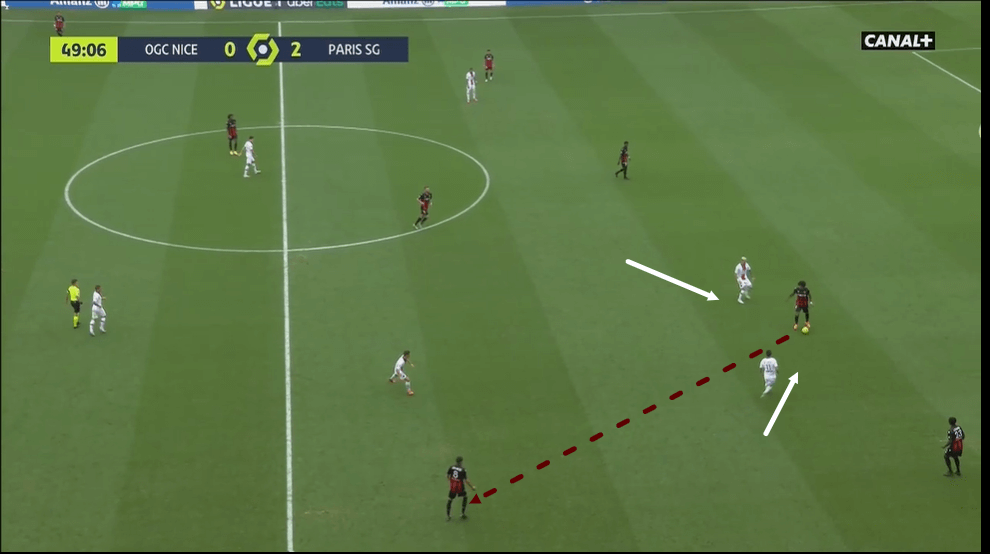
Lastly, this next image shows us Dante in possession of the ball in his left centre-back position just after receiving a pass. However, despite being pressed from the left and the right by two PSG players, he, once again, doesn’t panic or rush the play and instead, he actually seems to slow down the play and wait for the PSG players to get closer to him, all the while creating more time and space for his teammates near him who these two PSG players will now be too far away from to press effectively.
This is another example of Dante’s confidence, intelligence and his quality on the ball. He backs his ability to pull off this pass to the left-wing despite being under pressure and this pays off, as he does just that while playing the ball to a player in more space than him.
Conclusion
To conclude this tactical analysis piece, it’s clear that Dante plays a very important role for Nice in the build-up, with a lot of their build-up play hinging on him, his versatility, his intelligence and his composure on the ball.
It’s clear that the 36-year-old Brazilian plays an important part in Vieira’s tactics on the ball as his ball-carrying quality and deep-lying playmaking quality, as well as other mental and physical attributes that we have touched on in this tactical analysis piece, all come together to make him a key player for Les Aiglons.





Comments